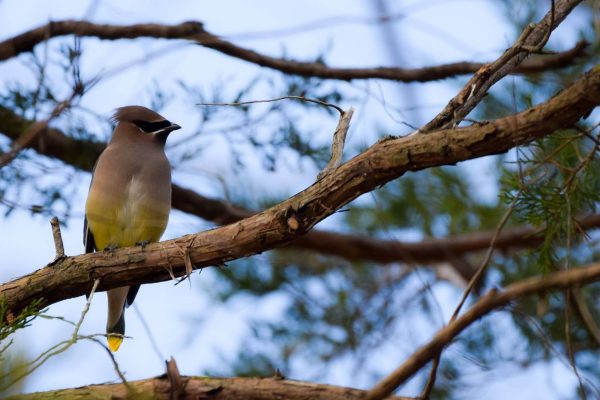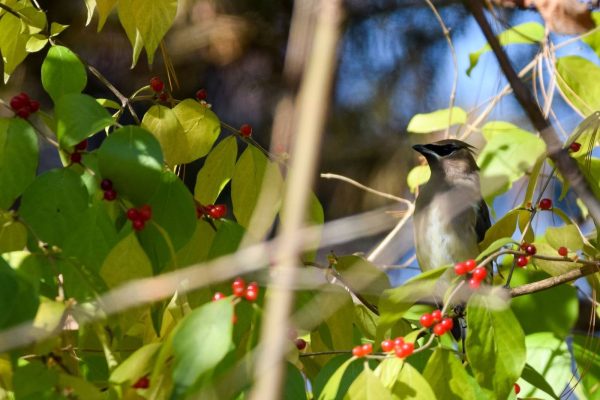Pennsylvania is home to an amazing array of bird diversity. As of 2024, over 430 species of birds have been reported from the Keystone state – a fair portion of which are consistently encountered. Of those species, there are a handful who elicit a great deal of appreciation from outdoor enthusiasts. Some, like the Long-eared Owl, are revered due to their rarity and cryptic nature. Others, like the Ruby-throated Hummingbird, are beloved for their tiny stature and exceptional physical abilities. There are some, however, whose praises are sung simply because they’ve got the looks. Of that subset of birds, there is one whose beauty might trump all others. They’re called Cedar Waxwings (Bombycilla cedrorum), and in this article, I’d like to supplement those praises by highlighting some of their ecology and natural history. There’s more to this species than just immaculate looks. Let’s delve deeper.
About Them
Cedar Waxwings belong to the monogeneric (containing only one genus) Bombycillidae family whose closest relatives are the silky flycatchers (Ptiliogonatidae). Neither family is particularly diverse, and there are actually only 3 species of waxwing in the entire world. Of the waxwings, Cedar Waxwings are by far the most commonly encountered in Pennsylvania. Bohemian Waxwings have also been reported but it’s a relatively rare bird to see here. Waxwings get their name from the waxy red tips found on some of their secondary wing feathers, which can be difficult to spot. The “cedar” portion of their name stems from their close relationship with cedars, or juniper trees.

Eating Habits
Unlike most songbirds, the diet of Cedar Waxwings is made up largely of fruit throughout the year. They will supplement their diet with protein-rich insects during the summer, but the fruit of various plant species meets their nutritional needs for most of the year. One type of fruit that they’re particularly fond of is the juniper “berry” produced by members of the Juniperus genus. They aren’t true berries, hence the quotation marks, but they’re round, bright fruit that are beloved by Cedar Waxwings nonetheless.
The most common juniper in this part of the country is the Eastern Red Cedar (Juniperus virginiana), which can be found in open meadows, along hedgerows in agricultural lands, and in a variety of other habitats too. During winter, it isn’t uncommon to come across Eastern Red Cedars that are covered in dozens of hungry Cedar Waxwings. Cedar Waxwings often have to compete with other species like American Robins for juniper berries, but as we’ll discuss next, Cedar Waxwings aren’t all that competitive.
Non-Territorial Tendencies
Most birds, and especially songbirds, are territorial for at least a portion of the year. Typically during the breeding season, songbirds will establish territories by broadcasting calls and elaborate songs, and will even chase other birds around should they wander too close to their resources. Cedar Waxwings, however, aren’t like other songbirds in that they’re considered to be non-territorial. Even during the breeding season, Cedar Waxwings rarely show aggression towards conspecifics (members of the same species) or other species for that matter.
Because their placement on the landscape is dictated by an abundance of fruit, they’re often on the move flocking from patch to patch, leaving little need to establish territories. Cedar Waxwings are gregarious nomads, in the truest sense.
Localities
Their pursuit of fruit often lands them in urban and suburban neighborhoods, where their dietary affinities can become a little problematic with respect to conservation. In urban and suburban settings, there’s often no shortage of fruit-bearing invasive plants. And while many birds have been found to favor fruit produced by native species over fruit produced by non-native species, that preference is only appreciable in instances where native species are present. Unfortunately, native fruit bearing plants such as various dogwoods, viburnums, and hawthorns are often missing in urban/suburban settings and replaced by non-native, ornamental, and often invasive species such as Japanese Honeysuckle, Japanese Barberry, Privet, and Buckthorn. Hence, Cedar Waxwings moving through cities and suburbs often consume the fruit of invasive species and may aid in the spread of those species.

That being said, the spread of invasive species via bird droppings isn’t exclusive to Cedar Waxwings. Many other birds eat invasive fruit and furthermore, the ability of birds to spread invasive species, whether it be via eating the fruit or seeds sticking to their feathers, is often context dependent. Areas with high levels of disturbance are more susceptible to invasive species establishing via birds than intact forests are. Like many problems in conservation, the Cedar Waxwing and invasive species conundrum stems from the much larger issue that is the destruction of our natural areas and the loss of native plants.
Conclusion
I hope this article has added to your appreciation of the Cedar Waxwing. They have a pretty large fandom, but their ecology and natural history is often eclipsed by their stunning looks. If you’re interested in helping Cedar Waxwings, I’d recommend planting some native viburnums, dogwoods, hawthorns, serviceberries, and of course, Eastern Red Cedars. You can encourage your local governments to do the same as well.
Thank you for reading!
Sebastian Harris, Conservation Easement Steward
Curious about pollinators, turtle crossings, reforestation and other woodsy things? Read more Nature Notes.
